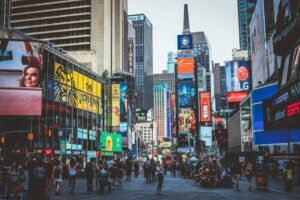
Hybrid Collapse creates a haunting visual universe where artificial intelligence meets myth, ritual, and biopolitics. Using AI-generated imagery and looping cinematic sequences, the project explores how power, identity, and the human body are reframed in the age of algorithmic perception — offering not clarity, but resonance.
In a world oversaturated with images, few projects manage to create a visual experience that lingers — haunting, hypnotic, and ideologically charged. Hybrid Collapse does just that. Through the use of AI-generated visuals, cinematic composition, and symbolic choreography, it builds a posthuman aesthetic that feels both futuristic and mythological, intimate and monumental.
But this is not just about style. The visual world of Hybrid Collapse is not a backdrop to the music — it is a parallel narrative, a second voice, a language of its own. Each frame, each gesture, each flickering symbol contributes to the project’s central concern: how is the human form reshaped, reframed, and ritualized in an age of algorithmic perception?
Artificial Vision, Real Emotion
Hybrid Collapse works with advanced generative tools — neural networks, diffusion models, video post-processing — but the goal is not technological spectacle. The aim is emotional intelligence. The visuals are not realistic; they are hyperreal. Not explanatory, but suggestive. They speak in atmosphere, gesture, and mood.
AI is not treated here as a neutral tool but as a collaborator with its own aesthetic logic. The distortions, glitches, repetitions, and uncanny facial features are not errors — they are part of the language. They reflect the new conditions of vision in a world where machines increasingly shape what and how we see.
The Body as Interface
Across the project’s videos and artworks, one motif recurs: the female body. But this is not a return to old tropes of eroticism or muse culture. The bodies in Hybrid Collapse are synthetic, mirrored, armored, duplicated. They are not subjects of desire — they are diagrams of power. They perform rituals, undergo transformations, and confront the gaze.
These figures are often placed in barren, symbolic spaces: cathedrals of metal, ritual chambers, flooded ruins. The setting becomes a stage for exploring biopolitical themes — sexuality, violence, obedience, resistance — not through direct narration, but through coded images and embodied gesture.
Loops and Liturgies
One of the most distinctive features of the Hybrid Collapse visual style is its use of looping video. Many of the works are built around short, repeating sequences — a dancer collapsing, a figure floating, a masked face turning toward the viewer. These loops create a trance-like experience. They deny resolution. They refuse linearity.
In a culture addicted to speed and novelty, these repetitions act like counter-spells. They invite contemplation. They transform passive watching into ritual participation. The viewer is not pushed forward — they are pulled inward.
Myth After the Machine
A striking feature of Hybrid Collapse is how its images feel ancient and futuristic at the same time. AI-generated priestesses, latex angels, and cybernetic twins evoke religious iconography, fashion photography, and science fiction all at once. This hybridization of styles creates a visual mythology — a kind of posthuman symbology for the 21st century.
The project doesn’t present a clear mythology. Instead, it gives fragments — echoes of archetypes, glimpses of rituals, unresolved symbols. It asks the viewer to assemble meaning from the ruins, to interpret and re-interpret the visual field like a dream or a tarot spread.
Against the Algorithmic Gaze
Perhaps the most radical gesture of Hybrid Collapse is its refusal to be “easy to consume.” The visuals are dark, dense, symbol-heavy. They resist the lightness and clarity that social media algorithms reward. They are not optimized for virality — they are designed for resonance.
In that sense, Hybrid Collapse is not just an art project — it is a form of resistance. It rejects the flattening of vision into content. It insists on slowness, ambiguity, and affect. It uses the tools of the system — AI, video platforms, aesthetic codes — but turns them against their own logic.
Toward a New Visual Ethics
As AI-generated imagery floods the internet, questions of ethics, authorship, and aesthetics become urgent. Hybrid Collapse does not offer clear answers, but it does offer a path: toward intentionality, toward symbolism, toward vision as philosophy. In this project, every image is a thought.






